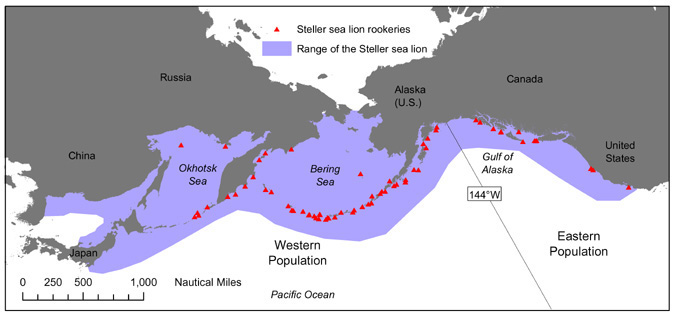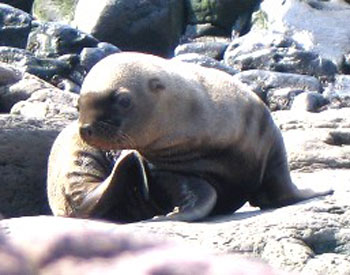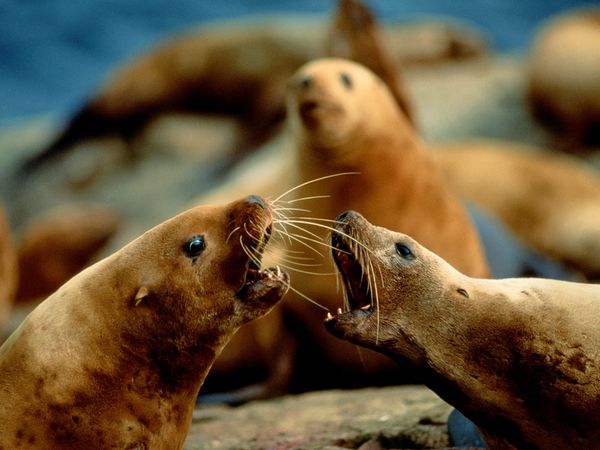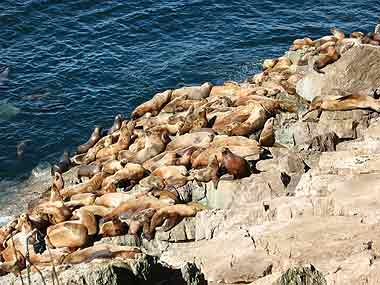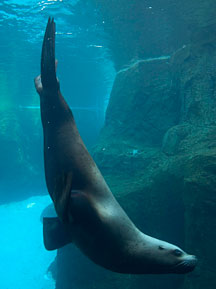| Annika | Stellar Sea Lion | |
| CLASSIFICATION
|
CLASSIFICATION
Right: Steller Sea Lions sun bathing on rocky shore in Resurrection Bay, Alaska 2009
In the wild females live an average of 30 years, while males live an average of 18 (mostly due to fighting during breeding season). Stellar sea lions are the largest of all the sea lions. Latin name means
“manned one with broad forehead.” Named so because the animal has a
very broad, high-set forehead (more so in the males) and a slightly
thicker tuft of hair around their necks. Sadly, stellar sea
lions are on the endangered species list. Stellar is a pretty cool name, huh? Stellar sea lion. What other animal has stellar in the name? That only makes these big guys sound awesome. Well, like anything else they were named after someone. Luckily Georg Wilhelm Stellar, who was the first to describe these beasts in writing, had a cool last name Also called the Northern Sea Lion. Stellar sea lions can turn their hind flippers forward for walking on land, unlike most other sea lions. . Above: Steller sea lion in captivity, on a rock 'roaring.' This photo was taken at the Sealife Center in Seward, Alaska 2008 by: Annika Dixon
Above: http://en.wikipedia.org/wiki/File:Eumetopias_jubatus_distribution2.jpg
Above: Steller Sea Lions sun bathing on rocky shore in Resurrection Bay, Alaska 2009 by: Annika Dixon
Above: http://www.vallarta-adventures.com/tours/sea-lion-encounter/fact Ever heard of a rookery? A rookery is a colony area for breeding, in this case, for the steller sea lions. Breeding normally takes place in May, on rookeries, which can normally be found on small islands or isolated beaches. Before baby making can began, males must hold their terriorty on a beach.Generally the older, larger males win their terriorty by fighting. Normally males aren't able to breed until eight years of age-at the least-because of this. Many males go over a month without eating to defend their territory. When females arrive to breed, they move freely about the established territories. Females began to reproduce at the age of five. Stellars often only have one pup at a time. Females will mate as soon as a week after giving birth! While breeding takes place in May, the rookies are where most the lion's time is spent. By the end of August the lions began spending more time in the water again. Females regonize their young by smell. Pretty cool, huh? And they bring back their pup fresh food, every single day. . Above: Steller sea lion pup http://www.theanimalfiles.com/mammals/seals_sea_lions/steller_sea_lion.html
Above: Steller sea lions preparing to spar: http://animals.nationalgeographic.com/animals/mammals/steller-sea-lion/ Above: Steller sea lions at Benjamin Island haulout - Juneau, Alaska. By:Greg Bledsoe http://www.alaskafisheries.noaa.gov/protectedresources/stellers/ BODY SYSTEMS Stellars have whiskers on their muzzle. Flippers are hairless and black. They molt every year, just like most other pinnipeds. They are able to live on both water and land.
Above: Steller Sea Lion in Oregon zoo, swimming http://www.oregonzoo.org/Cards/Steller_cove/sealion.htm
HUMAN
IMPACT Before the Endagered Species Act was ratified sea lions were hunted for their whiskers, which was used as pipe cleaners, and their penises were used as aphrodisiacs in Chinese medicine. Overfishing is guessed to be the main cause as population decline among the lions. Other scientists believe over preditation of ocras are causing the drop. Whatever the reason, many Marine biologists have been studying these mammals closly in the last decade. The Sealife Center in Seward, Alaska has constant video feed of over ten rookeries in the area for safety servallence. . Above: stellar sea lion population chart http://www.nmfs.noaa.gov/pr/species/mammals/pinnipeds/stellersealion.htm Above: Woody, stellar sea lion in captivity at the Sealife Center in Seward, Alaska. Device on his head is for rehabilitation. By: Annika Dixon 2008 http://www.alaskasealife.org/ http://en.wikipedia.org/wiki/Steller_sea_lion http://www.seaotter-sealion.org/stellersealion/factsssl.html http://www.oregonzoo.org/Cards/Steller_cove/sealion.htm http://www.fakr.noaa.gov/protectedresources/stellers/habitat.htm http://animals.nationalgeographic.com/animals/mammals/steller-sea-lion/ http://www.alaskafisheries.noaa.gov/protectedresources/stellers/ http://www.nmfs.noaa.gov/pr/species/mammals/pinnipeds/stellersealion.htm Sea lion photo: By Annika Dixon Sea lions on shore photo: by Annika Dixon Sea lion on rock photo: by Annika Dixon Sea lions on shore photo: by Annika Dixon Range photo: http://en.wikipedia.org/wiki/File:Eumetopias_jubatus_distribution2.jpg Sea lion eating photo: http://www.vallarta-adventures.com/tours/sea-lion-encounter/fact Sea lion pup photo: http://www.theanimalfiles.com/mammals/seals_sea_lions/steller_sea_lion.html Sea lions sparring photo: http://animals.nationalgeographic.com/animals/mammals/steller-sea-lion/ Photo of rookery: http://www.alaskafisheries.noaa.gov/protectedresources/stellers/ By:Greg Bledsoe Swimming lion photo: http://www.oregonzoo.org/Cards/Steller_cove/sealion.htm Population chart: http://www.nmfs.noaa.gov/pr/species/mammals/pinnipeds/stellersealion.htm Photo of sea lion: by Annika Dixon
|
